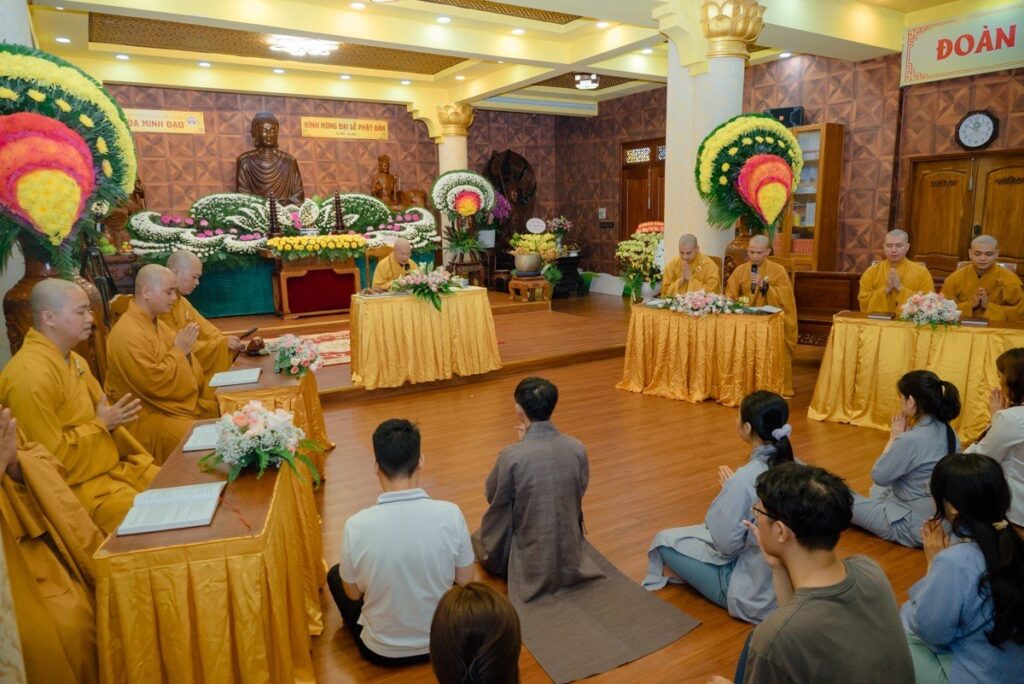As one of the oldest and most widespread religions in the world, Buddhism is rich in history, philosophy, and spiritual practices. At the heart of this tradition lies the concept of taking refuge in the Three Jewels: the Buddha, the Dharma, and the Sangha.
These three elements represent the foundation of Buddhist faith and practice, providing guidance and support for individuals seeking to overcome suffering and attain enlightenment. In this article, we will delve deeper into the meaning and benefits of taking refuge in the Three Jewels, exploring how these precious gems can illuminate your path towards inner peace and awakening.
What are the Three Jewels in Buddhism?

The Three Jewels (Sanskrit: Triratna, Pali: Tiratana), also known as the Triple Gem or the Three Refuges, are the core components of Buddhist practice and belief. They are the Buddha, the Dharma, and the Sangha, and together, they form the foundation of Buddhist philosophy and spirituality.
1. The first jewel is the Buddha
This refers to Siddhartha Gautama, who became the enlightened one after years of intense meditation and spiritual practice. The Buddha is considered the ultimate guide and teacher in Buddhism, and his teachings serve as the foundation of the Buddhist faith. The Buddha’s life and teachings offer a path to enlightenment, or Nirvana, which is the ultimate goal of Buddhist practice.
2. The second jewel is the Dharma
The second jewel is the Dharma, which refers to the teachings of the Buddha. These teachings are found in the Pali Canon, a collection of texts that describe the Buddha’s life and philosophy. The Dharma encompasses the Four Noble Truths, which state that suffering exists, suffering arises from craving and attachment, suffering can be overcome, and the path to the end of suffering is the Eightfold Path. The Dharma also includes ethical guidelines, meditation practices, and various philosophical concepts that guide Buddhist practice.
3. The third jewel is the Sangha
The third jewel is the Sangha, which refers to the Buddhist community. The Sangha is made up of ordained monks and nuns, as well as lay practitioners who follow the teachings of the Buddha. The Sangha provides support and guidance for individual practitioners, and it is also a source of inspiration and motivation for those seeking to deepen their spiritual practice. The Sangha is considered essential for the preservation and propagation of the Buddha’s teachings.
Together, the Three Jewels provide a framework for Buddhist practice and belief. They serve as a source of inspiration and guidance for those seeking to live a life of compassion, wisdom, and inner peace. By taking refuge in the Three Jewels, Buddhists affirm their commitment to the path of awakening and liberation from suffering.
Meaning of Taking Refuge in the Three Jewels

In the context of Buddhism, “taking refuge” in the Three Jewels—The Buddha, the Dharma, and the Sangha—is a significant spiritual act that signifies one’s formal commitment to follow the Buddhist path. To “take refuge” in this context is to seek protection, guidance, and support on the journey towards enlightenment.
In darkness, people rely on a lamp to illuminate the road ahead. Similarly, by taking refuge in the Three Jewels, individuals can find a safe haven to return to and seek refuge in amidst the ups and downs of life. If we take refuge in the Three Jewels and appreciate the benefits they bring, we can rely on them to guide us through the sea of suffering and lead us towards true happiness.
Taking refuge in the Buddha: When one takes refuge in the Buddha, they acknowledge and express faith in the Buddha as the embodiment of enlightened wisdom. It signifies the recognition of the Buddha as the supreme teacher who has shown the path to liberation. More profoundly, it represents the aspiration to achieve Buddhahood, the ultimate state of enlightenment, as exemplified by Gautama Buddha. This refuge recognizes that the potential for enlightenment resides within all sentient beings.
Taking refuge in the Dharma: Taking refuge in the Dharma denotes acceptance of and commitment to the teachings of the Buddha as the guiding truth. This signifies the determination to follow the Buddha’s teachings—comprising moral codes, meditation practices, wisdom teachings, and more—to eliminate suffering and attain enlightenment. Taking refuge in the Dharma also entails an acknowledgement that the teachings provide the means to understand the true nature of reality and the path towards liberation.
Taking refuge in the Sangha: When one takes refuge in the Sangha, they commit to being part of and learning from the community of individuals who are also on the path of enlightenment. The Sangha includes both the monastic community and the broader community of lay followers. This refuge implies an understanding that spiritual progress is fostered within a supportive and collective environment.
As explained by many Buddhist scholars, the Three Jewels can be likened to a “hospital”, where the Buddha acts as the “doctor”, the Dharma as the “medicine”, and the Sangha as the “nurse”. Together, the Three Jewels provide a place for individuals to turn to for healing their physical and mental suffering.
Taking refuge in the Three Jewels is not merely a ritualistic utterance, but a deeply personal and transformative pledge. It underscores the practitioner’s steadfast dedication to following the Buddhist path towards enlightenment. As such, it involves a conscious endeavor to cultivate wisdom, moral conduct, and mental discipline as guided by the Buddha, the Dharma and the Sangha. This act of taking refuge, while differing in particulars across various Buddhist traditions, universally marks one’s entry into the Buddhist faith.
Benefits of Taking Refuge in the Three Jewels

Taking refuge in the Three Jewels of Buddhism can bring numerous benefits to individuals on the spiritual path.
- Firstly, taking refuge in the Buddha can provide individuals with a role model for their own spiritual journey. The Buddha’s teachings and example of compassion and wisdom can inspire individuals to cultivate these qualities in themselves.
- Secondly, taking refuge in the Dharma can provide individuals with a framework for understanding the nature of suffering and the path to liberation. The Dharma can offer guidance on ethical conduct, meditation, and mindfulness, helping individuals develop inner peace and clarity.
- Thirdly, taking refuge in the Sangha can provide individuals with a supportive community of like-minded practitioners who can offer guidance, encouragement, and companionship on the path. The Sangha can also offer opportunities for service and generosity, helping individuals to develop a sense of connection and purpose.
In addition, according to Buddhist monks, taking refuge in the Three Jewels brings about 8 specific benefits as follows:
- We become a Buddhist, a follower of the Buddha
- It establishes the foundation for taking all further vows
- It helps purify our negative karma
- It helps us quickly accumulate positive potential (merit)
- We can’t be harmed by humans or non-humans
- We won’t fall to unfortunate rebirths
- Our virtuous aspirations will be fulfilled
- We will quickly attain Buddhahood
By taking refuge in the Three Jewels and cultivating these qualities, individuals can develop greater wisdom, compassion, and inner peace, and ultimately, attain liberation from suffering.
How does The Ritual of Taking Refuge in the Three Jewels Occur?
The ritual of taking refuge in the Three Jewels—Buddha, Dharma, and Sangha—represents a pivotal moment in a practitioner’s Buddhist journey, signifying a formal commitment to the Buddhist path.
Preparatory Phase: The ceremony begins with preliminary practices, including meditation and chanting, to purify the mind and cultivate a conducive mental state. Participants reflect on the significance of the Three Jewels and their intention to seek refuge.
Proclamation of Intent: The aspirant expresses the intention to take refuge, often in a congregational setting, affirming a commitment to the path of awakening. This declaration is typically made three times, symbolizing the deepening of this commitment.
Recitation of Refuge Formula: Under the guidance of a presiding monk or teacher, participants recite the refuge formula, typically in Pali or Sanskrit, affirming their trust and reliance on the Buddha as the awakened guide, the Dharma as the path of truth, and the Sangha as the community of noble practitioners. The recitation is often repeated three times, emphasizing the sincerity and depth of the aspirant’s commitment.
Receiving the Precepts: Following the recitation, participants may undertake the Five Precepts, ethical guidelines that form the basis of moral conduct in Buddhism. Accepting these precepts signifies a commitment to ethical living, a foundational aspect of Buddhist practice.
Dharma Talk and Blessing: The ceremony often includes a Dharma talk, providing insights into the meaning and implications of taking refuge. The presiding teacher or monk imparts teachings to inspire and guide the participants on their spiritual journey. The ceremony concludes with a blessing, invoking spiritual well-being and support for the practitioners’ path.
Integration into Daily Life: Taking refuge is not merely a ceremonial act but a profound commitment that extends into daily life. Practitioners are encouraged to integrate the principles and values of the Three Jewels into their everyday actions, thoughts, and decisions, thereby embodying the commitment to the Buddhist path in all aspects of their existence.
The ritual of taking refuge in the Three Jewels is a formal entry into the Buddhist path, marking a transition to a life guided by the principles of wisdom, ethical conduct, and mental cultivation. It reflects a deep commitment to personal transformation and the cultivation of compassion and wisdom for the benefit of all beings.






